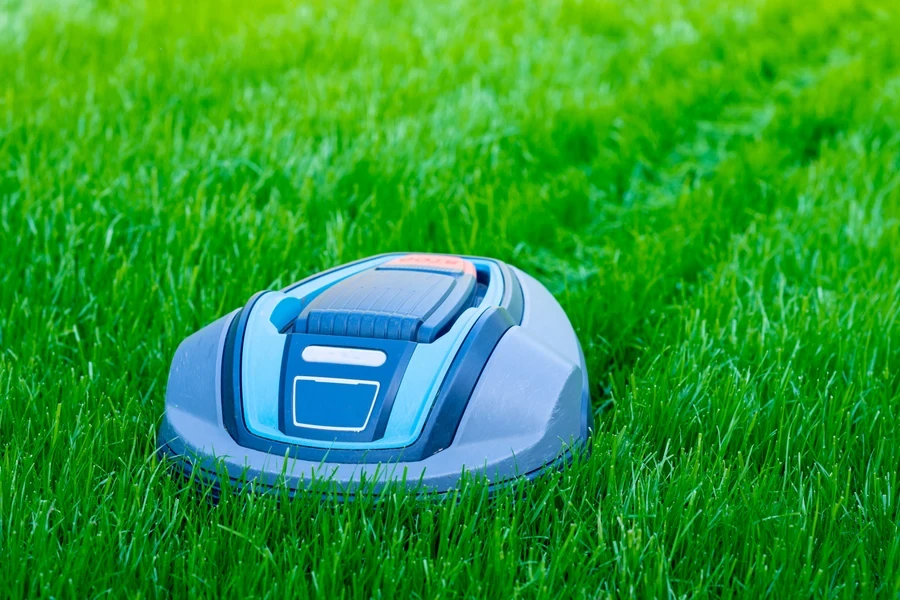Lawn mowing can be a stressful chore. But what if consumers could automate the process? That’s where the AI lawnmower comes in. These smart machines make yard work a breeze, offering easier and more precise mowing that’s way better than traditional ones.
Even better, they are easier on the environment. So, what should retailers consider before stocking these smart tools? This article will explore seven things they should consider when buying AI lawnmowers in bulk.
Table of Contents
7 things to consider when choosing AI lawnmowers
1. Understanding navigation systems
2. Lawn size and terrain matters
3. Battery life and charging efficiency
4. Cutting flexibility and mechanism
5. Smart features and connectivity
6. Safety features
7. Installation and setup
Bottom line
7 things to consider when choosing AI lawnmowers
1. Understanding navigation systems

One of the biggest differences between an AI and a traditional mower is its sense of direction. This feature helps it navigate the area users want to work on, depending on the boundaries. AI mowers can use wired boundaries, cameras, or GPS to navigate properly. Here’s a closer look at each type:
- Wired boundaries: AI lawnmowers with wired boundaries use physical wires that guide and limit their movement. These are more common in commercial or high-end residential areas requiring precise boundary control.
- Camera navigation: The camera-equipped robot mowers can see obstacles, understand the yard’s layout, and adjust their path on the fly, which is great for tricky or oddly shaped lawns.
- GPS-based systems: AI lawnmowers with GPS-based navigation are the better option for consumers with huge, open yards. They can map out areas successfully and plan their route, too.
2. Lawn size and terrain matters
Not every yard is the same, so it’s important to match the robotic lawn mowers capabilities with the size and type of terrain. For instance, customers with a small, flat garden will need a compact mower. They are lighter, easier to store, and have enough power to handle such lawns.
However, if consumers have a bigger yard with hilly, uneven patches, a small model obviously won’t cut it. Instead, they’ll need more powerful options with high-performing motors and high-traction wheels. Consider stocking models with enhanced stability if consumers have steeper slopes—a lifesaver for these buyers.
3. Battery life and charging efficiency

Another important factor to consider before choosing AI lawnmowers is battery life. Lithium-ion batteries are quite popular for these products because they are lightweight. They also offer faster recharging and last longer than the older nickel-cadmium types.
Regardless, the runtime still depends on the model. For this reason, AI lawnmowers can have a 2-3 hour runtime on a full charge, which works great for residential yards. Some other models can run for 3 to 4 hours, which is better for consumers with bigger lawns and more yard work.
Note: To offer consumers better longevity, focus on “lithium-ion” batteries with good cycle ratings (300+ cycles). If possible, look for manufacturers that offer smart battery management systems for more optimized charging.
4. Cutting flexibility and mechanism
Retailers should also check the AI mower’s cutting mechanism—it determines how well the device will adapt to different yard conditions. Focus on models with adjustable cutting heights so users can easily set the right height for different grass seasons.
Manufacturers may also offer models with multi-blade systems that give a neater finished look. However, retailers stocking these models should ensure they have rust-resistant blades so they don’t lose effectiveness when cutting wet grass.
Note: The size of the cutting deck also matters. A wider deck speeds up the job on large lawns, while a narrower one maneuvers easily in tighter spaces.
5. Smart features and connectivity

Like every other smart tool, AI lawnmowers have a suite of smart connectivity features. These features allow users to connect to them using their phones. They can do this through Wi-Fi or Bluetooth, which then allows consumers to control the mower through the app. Some attractive benefits include mowing scheduling, monitoring progress, and receiving maintenance alerts.
But that’s not all. Some manufacturers offer AI lawnmowers that connect to voice assistants like Alexa or Google. For this reason, consumers can easily add them to their smart home setup and start their yard work with a simple voice command. Remember to only stock AI lawnmowers with user-friendly apps and regular system updates.
6. Safety features

AI mowers often have various safety features to protect children or pets from getting hurt while active. Accidents can happen, so retailers should stock models with obstacle detection sensors to slow down or stop the blades if something steps onto the machine’s path.
They can also consider additional features like lift and tilt sensors to shut off the mower if someone picks it up or tips it over. While these features are great, they won’t matter if the manufacturer hasn’t passed safety regulations and tests, so check if they have any safety certifications that confirm reliability.
7. Installation and setup

Installation depends on the type of navigation consumers want on their AI lawnmowers. Here’s a closer look:
1. Virtual boundary setup
Robotic mowers with GPS-based navigation can let customers mark the mowing area directly on their smartphones. Thanks to the ability to draw the limits directly, they won’t need to install wires. However, it requires customers to get used to the app and set up their no-go zones.
2. Automatic mapping
Camera-based models are more automatic than other types, and manufacturers design them to work independently. Once consumers turn them on, they can set them to scan the yard with built-in cameras and sensors and create a map. For this reason, the setup is very simple, perfect for those who want a “turn it on and go” solution.
3. Physical wire installation:
Wire-based AI lawnmowers require consumers to install a thin, low-voltage perimeter wire around the cleaning area. Users can bury these wires under the floor, embed them in carpets, or attach them along baseboards. Consumers must also figure out how to connect it to a power source, which may require professional help.
Bottom line
AI lawnmowers are a great way for consumers to turn annoying yard work into something more enjoyable. While they are a significant investment, many consumers think the time they’ll get to do other things is worth it. So, retailers must ensure they aren’t wrong by considering the seven factors discussed here before stocking AI lawnmowers.




